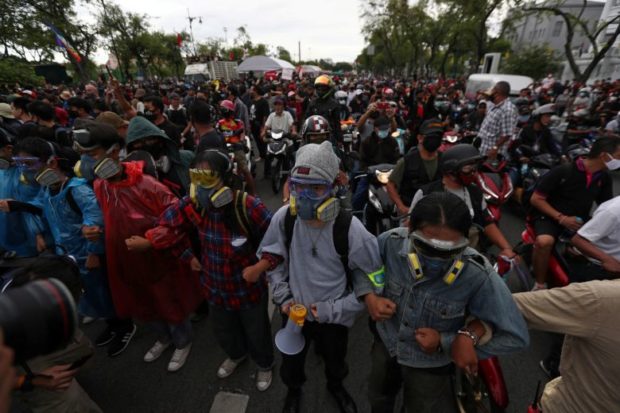
Pro-democracy protesters link arms during a mass rally in Bangkok on Sept 20, 2020. REUTERS via The Straits Times/Asia News Network
BANGKOK — Thousands of people gathered in Bangkok yesterday in the biggest anti-government demonstration since the coronavirus pandemic gripped the kingdom.
The protesters, led by university students and joined by political activists from other parts of the country, swarmed Sanam Luang, a field next to the Grand Palace which is normally fenced off and reserved for royal or official events. They pledged to camp overnight and march to a yet undisclosed government office today. Over 30,000 people were estimated to have turned up yesterday.
The weekend rally is the latest in a series of protests that have erupted all over Thailand against the coalition government led by Prime Minister Prayut Chan-o-cha, which critics argue is propped up by a Constitution specially written to cement the influence of the royalist pro-military establishment.
Unlike previous flash-mob-style protests, activists planned an extended sit-in this time round.
Led by a student group called the United Front of Thammasat and Demonstration (UFTD), the protesters are demanding reform of Thailand’s powerful and wealthy monarchy. During a rally on Aug 10, UFTD put forward 10 reform proposals which included reducing the budget for royal expenses and not excessively glorifying the monarchy.
The proposals caused an uproar among royalists, who regard the monarchy as an untouchable institution.
While the government has said it is open to constitutional change, it has called the demands for reform of the monarchy a “sensitive” topic. A 3.3 trillion baht (S$144 billion) budget for the coming fiscal year passed by the House of Representatives at its final reading on Friday included almost nine billion baht for palace expenses.
The protests are taking place at a time when Mr Prayut is facing tough economic challenges. Thailand’s economy is projected to shrink by 8.1 per cent at the year’s end and the Prime Minister is still struggling to fill the post of finance minister after former banker Predee Daochai hastily vacated the position earlier this month. The deep recession and looming mass unemployment has led to intense scrutiny on how tax money is spent.
Key UFTD member Parit Chiwarak told The Sunday Times yesterday: “When we mention our problems, we never talk about the real cause of it… This should end in our generation.”
A 21-year-old undergraduate from Thammasat University – a traditional hotbed of dissent – who was at the rally said the 10 proposals on the monarchy were intended to strengthen the institution for the future.
Also present at yesterday’s protest were many “red shirt” activists who played a key role in the past decade of color-coded political conflict in the kingdom – something the current generation of young protesters have little affinity with.
“They joined us with the same ideology, to demand for democracy,” said Mr Parit.
A 60-year-old red shirt supporter, who called herself Aew, said: “The students came out to protest because the red shirts failed to achieve our goals.”
The protesters, wearing black T-shirts, face masks and raincoats because of an intermittent drizzle, were largely peaceful. One report said at least 10,000 uniformed and plainclothes police officers were patrolling the area around the rally.
The government has so far avoided direct confrontation with the demonstrators. But Mr Prayut, in his strongest comments yet, said on Thursday: “When you gather in mobs, you are creating an enormous risk of new infections. And with that, you also create enormous risk to the livelihoods of tens of millions of fellow Thais.”
He said that while he had asked the police to be tolerant, the protests will delay business recovery by affecting business confidence and make tourists think twice about returning to Thailand.